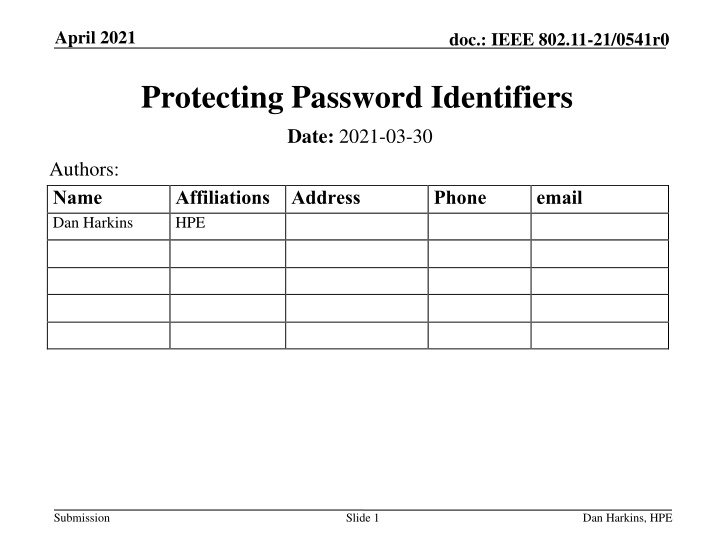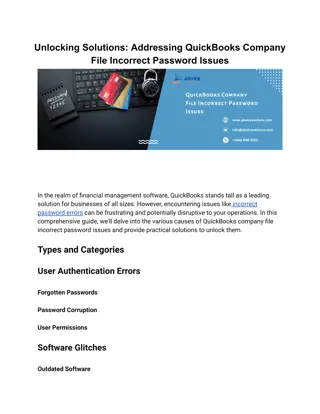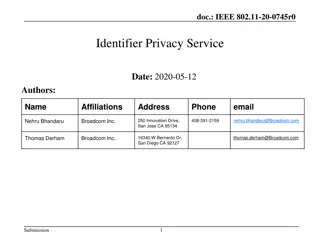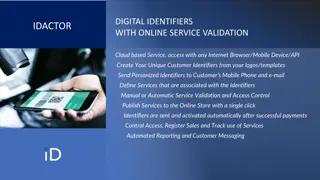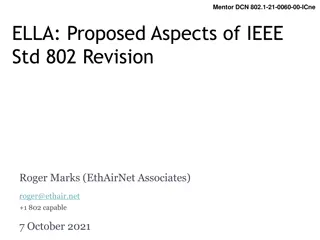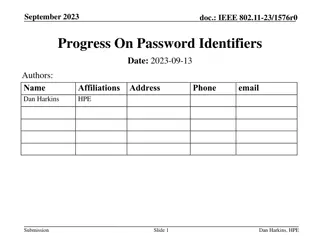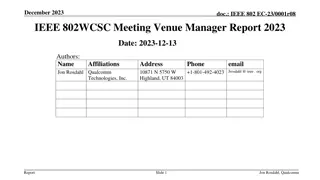Protecting Password Identifiers in IEEE 802.11-21
This submission addresses the need for safeguarding password identifiers in SAE to ensure privacy and prevent attackers from constructing personally identifiable information. The document presents two potential solutions, ultimately recommending the use of symmetric cryptography for efficient protection. By encrypting password identifiers with a symmetric key, each association receives a unique pseudonym for secure communication.
Download Presentation

Please find below an Image/Link to download the presentation.
The content on the website is provided AS IS for your information and personal use only. It may not be sold, licensed, or shared on other websites without obtaining consent from the author.If you encounter any issues during the download, it is possible that the publisher has removed the file from their server.
You are allowed to download the files provided on this website for personal or commercial use, subject to the condition that they are used lawfully. All files are the property of their respective owners.
The content on the website is provided AS IS for your information and personal use only. It may not be sold, licensed, or shared on other websites without obtaining consent from the author.
E N D
Presentation Transcript
April 2021 doc.: IEEE 802.11-21/0541r0 Protecting Password Identifiers Date: 2021-03-30 Authors: Name Dan Harkins Affiliations Address HPE Phone email Submission Slide 1 Dan Harkins, HPE
April 2021 doc.: IEEE 802.11-21/0541r0 Abstract This submission discusses protection of password identifiers in SAE Submission Slide 2 Dan Harkins, HPE
April 2021 doc.: IEEE 802.11-21/0541r0 What s The Problem? Password identifiers are used to look up passwords Passwords could be for groups of users the way they re used now or per-user In degenerate case, they could become like usernames Password identifiers are passed in the clear STA is a member of an identified group for shared passwords STA is a particular individual when used like usernames We need to provide privacy to password identifiers Give the attacker no information about the underlying identity Prevent the attacker from using constructing PII PII! Submission Slide 3 Dan Harkins, HPE
April 2021 doc.: IEEE 802.11-21/0541r0 Two Possible Solutions 1. Asymmetric crypto AP has a trusted public key, STA does HPKE-like wrapping of password identifier Pros: good, modular use of secure building blocks Cons: requires distribution of trusted public key, slower, bulkier, possible DOS issues 2. Symmetric crypto AP creates a stateless pseudonym that it can decipher later on Pros: faster, lower overhead Cons: first connection is with a plaintext identifier Let s choose option 2 (trusted public key distribution is hard) Submission Slide 4 Dan Harkins, HPE
April 2021 doc.: IEEE 802.11-21/0541r0 Solution (broadly speaking) Have AP maintain a symmetric key First time the STA associates it does so with an unprotected password identifier AP encrypts the password identifier (with some salt) and gives it back to the STA during the 4way HS Subsequent association is with encrypted password identifier, STA gets a new and different pseudonym in the subsequent 4way HS Each association will have a unique password identifier that can be decrypted by the AP If STA doesn t understand protected password identifiers it will just respond in the clear again Slide 5 Submission Dan Harkins, HPE
April 2021 doc.: IEEE 802.11-21/0541r0 Issue to Consider Everyone who can receive a pseudonym has to be able to decrypt it For ESS, that means all APs share the same symmetric key For mesh, that means every mesh point (everyone?) shares the same symmetric key What s the Issue? STA identities can be protected against other STAs in an ESS a STA will not know what group another STA is in even if it s the same group Group membership cannot be protected against other mesh points in a mesh (just like APs are not protected against other APs) Submission Slide 6 Dan Harkins, HPE
April 2021 doc.: IEEE 802.11-21/0541r0 Protected Identifiers and Mesh Random MACs and different passwords per-mesh point links make encrypted password identifiers difficult to use There is no way to know which encrypted password identifier to use when constructing a Commit message Mesh point can generate its own protected identifier but that assumes recipients will know it, and if every mesh point knows the password and identifier of every other mesh point, then what s the point of doing different passwords per-mesh link? Same security as a single password OK, then what if it s not random MACs? Then what s the privacy concern? The fixed MAC is the identity bound to the password! No need to use protected password identifiers! Well, what if there s a single password for the whole mesh? There is no point in using password identifiers then! Conclusion: password identifiers don t really work with mesh Submission Slide 7 Dan Harkins, HPE
April 2021 doc.: IEEE 802.11-21/0541r0 Proposal All APs in ESS share a symmetric key Password identifier is padded and encrypted with an 8 octet random nonce which is used as a tweak to generate a stateless, one-time-use, pseudonym Pseudonym is given out to STA using a KDE in the 4- way handshake Pseudonym is transferred via IE in next SAE Commit Peculiarities of mesh All mesh points must use the same symmetric key to generate and validate protected password identities Each mesh point will generate its own protected password identifier There s little point in doing password identifiers with mesh though Submission Slide 8 Dan Harkins, HPE
April 2021 doc.: IEEE 802.11-21/0541r0 password identifier: blahfubar 4000blahfubar padded: tweaked: 71a08cf14000blahfubar key AES-SIV protected password identifier: 891b52f0725635f3abc8a6b13159df5afbf0a Submission Slide 9 Dan Harkins, HPE
April 2021 doc.: IEEE 802.11-21/0541r0 Properties of Proposed Scheme A passive attacker cannot determine a protected identity; Identifiers are protected against active attack insofar as SAE is resistant to active attack; A passive attacker cannot connect protected identities across SAE protocol runs Password identifiers can be arbitrarily padded to foil passive traffic analysis; Protected identities are secure under a birthday bound of 232 encryptions; An attacker cannot substitute identifiers to connect distinct runs of SAE; An AP needs to only manage a single symmetric secret; APs in an ESS, and all mesh points in a mesh, share a single symmetric secret (in an out of band, out of scope manner); AP can use the same symmetric secret to protect all groups in the ESS that use password identifiers; Identities are protected against members of the same group, except in a mesh; The interface for password identifiers on a STA is unchanged; The overhead is minimal 25 octets plus padding; Uses symmetric cryptography for speed and DOS resistance Submission Slide 10 Dan Harkins, HPE
April 2021 doc.: IEEE 802.11-21/0541r0 References 11-21/0488r0 Submission Slide 11 Dan Harkins, HPE
